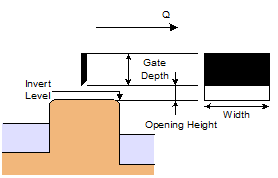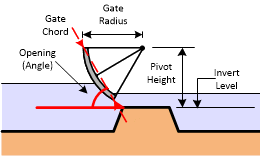Sluice Data Fields
Sluice gates or penstocks are rectangular drop gates and may be used as the outflow control on storage tanks or ponds. They can also be set to a fixed opening. Sluice gates can be adjusted during the analysis to represent manual or automatic operation of the gate.
Sluice data can be edited on either the Sluice Grid Window of the Links Grid or the Sluice Property Sheet.
To view and edit all sluice data, use the Property Sheet.
This table describes all the sluice specific data which can be used to define a sluice. For details of results fields, see the Link Results Data Fields topic.
 Common Data Fields
Common Data Fields Fields that are common to the majority of objects can be found in the Common Fields topic.
Sluice Data
Database Table Name: hw_sluice
|
Field Name |
Help Text |
Database Field |
Size |
Precision |
Default |
Error Lower Limit |
Error Upper Limit |
Warning Lower Limit |
Warning Upper Limit |
|||||||||||||||||||||||
|---|---|---|---|---|---|---|---|---|---|---|---|---|---|---|---|---|---|---|---|---|---|---|---|---|---|---|---|---|---|---|---|---|
|
Invert level |
The level at which the sluice gate operates.
|
invert |
Double |
|
Z |
3 |
|
-9999 |
9999 |
|
6000 |
|||||||||||||||||||||
|
Width |
The width of the rectangular sluice gate. |
width |
Double |
|
L |
3 |
|
0.1 |
|
|
|
|||||||||||||||||||||
|
Discharge coefficient |
Coefficient for the orifice flow equations. Where gates are fully submerged the behaviour is generally in a manner predicted by the discharge theory for an orifice. A typical overall velocity and contraction coefficient is therefore the default value of 1.0. |
discharge_coeff |
Double |
|
|
2 |
1 |
0.01 |
|
|
|
|||||||||||||||||||||
|
Secondary discharge coefficient |
This applies when the depth of water is less than the opening of the gate, and weir equations apply. |
secondary_discharge_coeff |
Double |
|
|
2 |
|
0.01 |
|
|
|
|||||||||||||||||||||
|
Overgate discharge coefficient |
This applies when the gate is overtopped. |
overgate_discharge_coeff |
Double |
|
|
2 |
1 |
0.01 |
|
|
|
|||||||||||||||||||||
|
Opening |
The opening (in unit length) for a vertical sluice gate. This is used as the Initial Opening for a variable opening vertical sluice (VSGate). |
opening |
Double |
|
L |
3 |
|
0 |
|
|
|
|||||||||||||||||||||
|
Opening |
The opening (in degrees) for a radial sluice gate. This is the angle of the gate chord from the horizontal. Horizontal (below the pivot) corresponds to a gate opening of 0 degrees.
This is used as the Initial Opening for a variable opening radial sluice (VRGate) See Pivot height for further details. |
opening_degrees |
Double |
|
ANGLE |
3 |
|
0 |
|
|
|
|||||||||||||||||||||
|
Gate depth |
Depth of gate (dimension from bottom to top of gate). Applicable to vertical sluice gates. If no gate height is specified, the sluice should never overtop. |
gate_depth |
Double |
|
L |
3 |
|
0 |
|
|
|
|||||||||||||||||||||
|
Pivot height |
Height of pivot of gate above invert. Applicable to radial sluice gates.
|
pivot_height |
Double |
|
L |
3 |
0 |
0 |
|
|
|
|||||||||||||||||||||
|
Gate chord |
Straight line distance between the top and bottom ends of the gate - i.e. the chord of the circle of which the gate itself is an arc. Applicable to radial sluice gates.
|
gate_chord |
Double |
|
L |
3 |
0 |
0 |
|
|
|
|||||||||||||||||||||
|
Gate radius |
Radius of gate. Applicable to radial sluice gates. See Pivot Height for further details. |
gate_radius |
Double |
|
L |
3 |
0 |
0 |
|
|
|
|||||||||||||||||||||
|
Minimum opening |
The minimum opening for the sluice gate. Applicable to vertical sluice gates. |
minimum_opening |
Double |
|
L |
3 |
0 |
0 |
|
|
|
|||||||||||||||||||||
|
Maximum Opening |
The maximum opening for the sluice gate. Applicable to vertical sluice gates. |
maximum_opening |
Double |
|
L |
3 |
999 |
0 |
|
|
|
|||||||||||||||||||||
|
Positive speed |
The rate at which the sluice gate opens. The value must be greater than zero. Applicable to vertical sluice gates. |
positive_speed |
Double |
|
DY |
5 |
|
0.000001 |
|
|
|
|||||||||||||||||||||
|
Negative speed |
The rate at which the sluice gate closes. The value must be greater than zero. Applicable to vertical sluice gates. |
negative_speed |
Double |
|
DY |
5 |
|
0.000001 |
|
|
|
|||||||||||||||||||||
|
Threshold |
The minimum change in opening which the software will implement. Any smaller change will be ignored. This prevents oscillation. Applicable to vertical sluice gates. |
threshold |
Double |
|
L |
3 |
0 |
0 |
|
|
|
|||||||||||||||||||||
|
Minimum opening |
The minimum opening (in degrees) for the sluice gate. Applicable to radial sluice gates. |
minimum_opening_deg |
Double |
|
ANGLE |
3 |
0 |
0 |
|
|
|
|||||||||||||||||||||
|
Maximum opening |
The maximum opening (in degrees) for the sluice gate. Applicable to radial sluice gates. |
maximum_opening_deg |
Double |
|
ANGLE |
3 |
999 |
0 |
|
|
|
|||||||||||||||||||||
|
Positive speed |
The rate at which the sluice gate opens (in degrees /.s). The value must be greater than zero. Applicable to radial sluice gates. |
positive_speed_deg |
Double |
|
ANGLEV |
5 |
|
0.000001 |
|
|
|
|||||||||||||||||||||
|
Negative speed |
The rate at which the sluice gate closes (in degrees / s). The value must be greater than zero. Applicable to radial sluice gates. |
negative_speed_deg |
Double |
|
ANGLEV |
5 |
|
0.000001 |
|
|
|
|||||||||||||||||||||
|
Threshold |
The minimum change in opening (in degrees) which the software will implement. Any smaller change will be ignored. This prevents oscillation. Applicable to radial sluice gates. |
threshold_degrees |
Double |
|
ANGLE |
3 |
0 |
0 |
|
|
|
|||||||||||||||||||||
|
US node ID |
Type in a node reference or choose an existing node reference from the drop down list. This makes up the first part of the link reference. |
us_node_id |
Text |
64 |
|
0 |
|
|
|
|
|
|||||||||||||||||||||
|
Link suffix |
A single character between A and Z or 0 and 9 which completes the link reference. This allows a node to have up to 36 downstream links. The suffix is automatically allocated by the software. |
link_suffix |
Text |
1 |
|
0 |
1 |
|
|
|
|
|||||||||||||||||||||
|
DS node ID |
Type in a node reference, or choose an existing node reference from the dropdown list |
ds_node_id |
Text |
64 |
|
0 |
|
|
|
|
|
|||||||||||||||||||||
|
Link type |
The sub-type for this sluice. Select from the dropdown list.
|
link_type |
Text |
6 |
|
0 |
SLUICE |
|
|
|
|
|||||||||||||||||||||
|
System type |
Choose the system type from the dropdown list. See System Type for more information
|
system_type |
Text |
10 |
|
0 |
Other |
|
|
|
|
|||||||||||||||||||||
|
Asset ID |
For reference only. Designed as a reference to an asset database, but could be used for anything. |
asset_id |
Text |
64 |
|
0 |
|
|
|
|
|
|||||||||||||||||||||
|
Sewer reference |
An optional reference to identify the sewer of which this conduit is a part. |
sewer_reference |
Text |
80 |
|
0 |
|
|
|
|
|
|||||||||||||||||||||
|
Points |
This field defines the geometry of the link. The underlying data consists of a series of (x,y) pairs defining the vertices of the link. Each link is made up of a series of straight lines between the defined (x,y) points. This data is not displayed on the grid or property sheet.  Link Vertice Export Link Vertice Export
Link vertices are included when you export link data to CSV files. There are two options available for exporting link vertices. These are selected on the Select CSV Export Options Dialog using the Coordinate Arrays Format dropdown list. The options are:
|
point_array |
Array |
|
XY |
0 |
|
|
|
|
|
|||||||||||||||||||||
|
DS settlement efficiency (%) |
See US settlement efficiency. |
ds_settlement_eff |
Long Integer |
|
|
0 |
0 |
0 |
100 |
|
|
|||||||||||||||||||||
|
US settlement efficiency (%) |
The settlement efficiency fields allow you to set the effectiveness of an overflow for trapping out sediment. The overflow is a link (normally a pipe) attached to a node acting as a storage tank (storage node or manhole). Normally the upstream end of the link will be attached to the node and act as the overflow. The upstream settlement efficiency determines the efficiency for the overflow. In some circumstances the link may be reversed (storage tank at the downstream end) and the downstream settlement efficiency will be used. In many cases an overflow will attach to an outfall from the system. It would be very unusual to have both upstream settlement efficiency and downstream settlement efficiency set to non-zero values. The valid range is 0-100%. 0% means the overflow acts as a normal continuation link. 100% means that the overflow traps out as much sediment as possible. |
us_settlement_eff |
Long Integer |
|
|
0 |
0 |
0 |
100 |
|
|
|||||||||||||||||||||
|
Branch ID |
Numeric field used to identify to which long section the link is associated. Can be set manually or automatically (see Defining Branches topic for more information). |
branch_id |
Long Integer |
|
|
0 |
|
0 |
|
|
|
|||||||||||||||||||||
|
InfoAsset unique ID |
Unique ID associated with the corresponding object in an InfoAsset Manager database. When importing from InfoAsset Manager, the InfoAsset ID can be copied from the InfoAsset database in order to maintain links between the two networks. |
asset_uid |
GUID |
|
|
0 |
|
0 |
0 |
0 |
0 |
|||||||||||||||||||||
| InfoAsset ID |
Used to store the ID of the corresponding InfoAsset object when Importing from a Collection Network. |
infonet_id | Text | 40 | 0 |





 Water Quality
Water Quality
